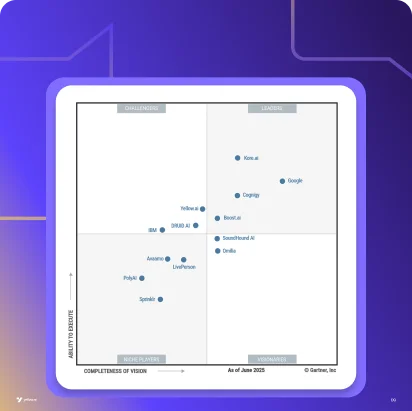The tech world is buzzing again. GPT-5 has arrived with promises of PhD-level reasoning, massive context windows, and near-zero hallucinations. LinkedIn is flooded with proclamations that this is finally the AI breakthrough that will revolutionize customer experience.
But here’s what I’ve learned from working with hundreds of enterprises deploying AI at scale: the most powerful model in the world won’t fix a fundamentally broken AI strategy.
I’ve seen this pattern repeat with every major model release. Companies rush to upgrade from GPT-4 to GPT-5, expecting transformational results, only to discover they’re still struggling with the same fundamental challenges, just faster and more expensively.
The real question isn’t whether GPT-5 is impressive (it absolutely is), but whether your organization is ready to harness its capabilities in ways that actually drive business outcomes.
What Seems Promising in GPT-5?
Let’s cut through the marketing noise and focus on what matters for enterprise deployments:
Dynamic Intelligence Routing: GPT-5 introduces a unified architecture that automatically switches between “fast” and “deep thinking” modes. Instead of paying for maximum compute on every query, you only use expensive reasoning when you need it, and it could fundamentally change how we think about AI cost management.
Massive Context Understanding: With context windows approaching 400K+ tokens (some reports suggest up to 1 million), GPT-5 can maintain context across entire customer journeys, complex documentation, and multi-session interactions. For enterprises managing intricate customer relationships, this represents a genuine leap forward.
Multimodal Sophistication: The improved ability to process images, documents, and text simultaneously opens possibilities for more natural customer service flows—think handling invoice disputes with visual document analysis in real-time conversations.
Reduced Hallucinations: Early testing shows hallucination rates dropping below 1% in many scenarios. For enterprises where accuracy isn’t just preferred but compliance-critical, this matters enormously.
My two cents: These capabilities only transform outcomes when they’re embedded within purpose-built agentic architectures.
Why Upgrading Model Alone Will Likely Lead to Failure
Let’s say you are a CX leader of an enterprise-grade CX operation who has spent 4 months integrating GPT-4 into their automation and has only seen minimal impact on your customer satisfaction scores. If your immediate reaction to GPT-5’s announcement is “Let’s upgrade immediately—this will surely fix our issues.”, you might want to pause and reassess.
This belief that better models automatically create better experiences is a fallacy. Here’s what you need to be mindful of:
Integration Reality Check: GPT-5 isn’t plug-and-play with existing GPT-4 implementations. API changes, prompt engineering adjustments, and memory pattern shifts mean significant development work. Companies often underestimate this friction.
The Orchestration Gap: Most enterprise AI deployments today are essentially sophisticated chatbots. They can engage in conversation but can’t take autonomous action, coordinate across systems, or drive processes to completion like Agentic AI agents. GPT-5’s enhanced capabilities amplify this limitation rather than solve it.
Metric Fixation Problem: Recent research shows 83% of enterprise AI metrics focus purely on technical performance (response time, accuracy) while ignoring human impact, safety measures, and other more telling metrics like first-call resolution rates, AI-to-human handoff rates, customer effort scores, time to resolution and other such outcomes relevant to support in the AI era.
Key Insight: A more capable model optimizing for the wrong metrics will just set you up for a faster and more expensive failure.
Where GPT-5 Could Truly Shine
A McKinsey article I was reading recently, opened with a brutal line: “Gen AI is everywhere—except in the company P&L.” Despite 78% of companies implementing generative AI, most deployments have failed to materially impact earnings. McKinsey calls this the “Gen AI paradox”, and the solution they are proposing isn’t more chatbots, but AI agents.
Agentic AI systems are autonomous, goal-driven agents that can plan multi-step workflows, adapt to changing conditions, and orchestrate actions across enterprise systems. GPT-5’s enhanced capabilities could unlock new possibilities for these systems:
- Complex Case Resolution: GPT-5’s improved reasoning could enable agents to handle multi-step customer issues that currently require human escalation, analyzing account history, coordinating with multiple departments, and resolving issues end-to-end.
- Intelligent Tool Orchestration: Rather than just answering questions, GPT-5-powered agents could trigger CRM updates, initiate workflows, schedule callbacks, and coordinate handoffs more reliably across your enterprise stack.
- Adaptive Learning: With extended context windows, agents could learn from entire customer relationships, not just individual interactions, enabling truly personalized service at scale.
At Yellow.ai, we’re already seeing enterprises with agentic architectures achieve 40-60% deflection rates for complex queries using current models, not just simple FAQ responses, but through genuine problem resolution by AI agents that previously required human intervention.
GPT-5’s capabilities suggest even greater possibilities.
Getting the best out of GPT-5 for Your Enterprise CX
Based on our experience helping enterprises navigate AI evolution, here’s how to approach GPT-5 strategically:
1. Architect for Evolution, Not Just GPT-5
The biggest mistake is building specifically for GPT-5. Instead, create abstraction layers that allow you to leverage GPT-5’s capabilities while remaining model-agnostic. The AI landscape moves too quickly to bet everything on any single model.
Pro tip: Your workflows should be enhanced by GPT-5, not dependent on it.
2. Start with Agentic Use Cases
Don’t just upgrade existing bots to GPT-5. Identify workflows where autonomous action drives clear business value:
- Complex tickets that requires cross-system coordination
- Multi-step processes with conditional logic
- Escalation management that involves multiple departments
3. Measure What Matters
Technical metrics (response time, accuracy) are table stakes. Focus on business outcomes:
- First-call resolution rates for complex queries (not just simple deflection)
- End-to-end time to resolution across the entire customer journey
- Customer effort scores for issues that previously required escalation
- AI-to-human handoff rates and escalation patterns
- Cost per resolution including agent productivity gains
4. Choose Vendors Who Can Handle Complexity
Remember, like any new model, GPT-5 integration will involve prompt migration, memory management, safety updates, and cost optimization across different reasoning modes. The right platform will handle this complexity for you, not pass it along.
5. Build Redundancy and Optionality
Even with GPT-5’s improvements, single points of failure remain risky. Architect systems that can gracefully fall back to alternative models or human handoffs when needed.
Did you know: Our customers aren’t betting on GPT-5 or any single model, they’re betting on outcomes. The Yellow.ai platform leverages 15+ proprietary and third-party LLMs to ensure optimal results regardless of which models rise or fall. This means higher accuracy, speed, and cost optimization without vendor lock-in.
Final Words
GPT-5 represents genuine progress in AI capabilities, but it’s not the destination. I see it as a potent fuel for intelligent autonomous orchestration at enterprise scale.
The next phase in enterprise service is essentially about reimagining how work gets done when intelligent agents can reason, plan, and act autonomously across your entire enterprise.The AI landscape will continue evolving at breakneck speed. GPT-6, GPT-7, and innovations from Anthropic, Google, and others are already in development. The question isn’t which model will be best, but whether your organization is building the operational intelligence to harness whatever comes next.
Related read: Building an AI Strategy That Survives Rapid Evolution of LLMs
Ready to explore how agentic AI can transform your customer experience?























